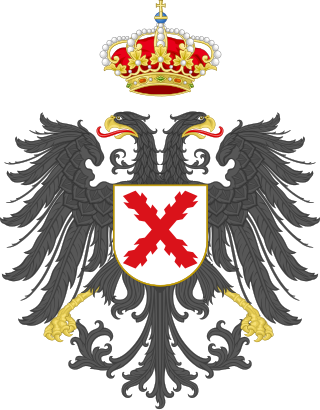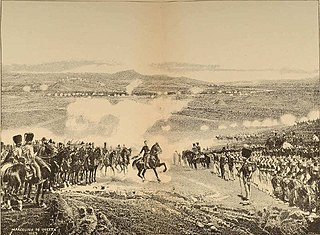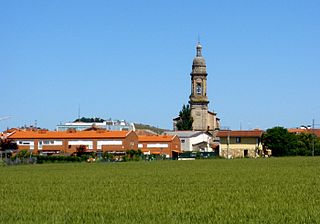
Tomás de Zumalacárregui e Imaz, known among his troops as "Uncle Tomás", was a Spanish Basque officer who led the Carlist faction as Captain general of the Army during the First Carlist War. He was occasionally nicknamed the "Wolf of the Amezcoas", making reference to his famous military victory in the region of Navarre.

Carlism is a Traditionalist and Legitimist political movement in Spain aimed at establishing an alternative branch of the Bourbon dynasty, one descended from Don Carlos, Count of Molina (1788–1855), on the Spanish throne.

The First Carlist War was a civil war in Spain from 1833 to 1840, the first of three Carlist Wars. It was fought between two factions over the succession to the throne and the nature of the Spanish monarchy: the conservative and devolutionist supporters of the late king's brother, Carlos de Borbón, became known as Carlists (carlistas), while the progressive and centralist supporters of the regent, Maria Christina, acting for Isabella II of Spain, were called Liberals (liberales), cristinos or isabelinos. Aside from being a war of succession about the question who the rightful successor to King Ferdinand VII of Spain was, the Carlists' goal was the return to a traditional monarchy, while the Liberals sought to defend the constitutional monarchy.

Rafael Maroto Yserns was a Spanish general, known both for his involvement on the Spanish side in the wars of independence in South America and on the Carlist side in the First Carlist War.

Luis Fernández de Córdova was a Spanish military general, diplomat and first Marquis of Mendigorria.

The Battle of Oriamendi was fought on 16 March 1837 during the First Carlist War. The battle was an overwhelming victory for the Carlists.
The Battle of Mendaza was an early battle of the First Carlist War, occurring on December 12, 1834, at Mendaza, Navarre.

Marcelino de Oraá Lecumberri (1788–1851) was a Spanish military man and administrator. Born in Beriáin in Navarre, he distinguished himself as a cadet during the War of Spanish Independence. He was married to Josefa de Erice, later Condesa de Chiva y Vizcondesa de Oráa.

The Battle of Mendigorría Grand took place during the First Carlist War on July 16, 1835 south of Mendigorría, Navarre. The Carlists were commanded by Vicente González Moreno, who assumed this post after the death of Zumalacárregui at the Siege of Bilbao. The Carlist pretender Don Carlos was also at Mendigorría.

The Battle of Ramales, a battle of the First Carlist War, occurred at Ramales in Cantabria on May 12, 1839. The successful Liberals were commanded by Baldomero Espartero, the Carlists by Rafael Maroto.

The Battle of Villarrobledo took place during the First Carlist War on September 20, 1836, south of Villarrobledo at a campground called Vega de San Cristóbal, which lies near a hermitage of the same name. However, there were also casualties reported in Villarrobledo proper. The battle was a major defeat for the Carlist general Miguel Gómez Damas, and his forces suffered large casualties, as well as the loss of large amounts of munitions. For his victory, Isidro de Alaix Fábregas was given the title of Viscount of Villarrobledo and was awarded the Laureate Cross of Saint Ferdinand.

The Lord Eliot Convention, or simply the Eliot Convention or Eliot Treaty, was an April 1835 agreement brokered by Edward Eliot, 3rd Earl of St Germans between the two opposing sides of Spain's First Carlist War. It had as its aim not to end the war itself but to end the indiscriminate executions of prisoners of war by firing squad that had been committed by both sides.

Chapelgorris, also called Peseteros, were a type of volunteer unit during the First Carlist War, raised at the beginning of the war in the province of Guipúzcoa. They fought against the Carlists.

Charles Frederick Henningsen was a Belgian-American writer, mercenary, filibuster, and munitions expert. He participated in revolutions and civil wars in Spain, Circassia, Hungary, Nicaragua, and the United States
The Battle of Alsasua, also known as the Battle of Altsasu or la Acción de la Venta de Alsasua, occurred on April 22, 1834 in Navarre, Spain, during the First Carlist War. Carlist general Tomás de Zumalacárregui attacked a convoy led by the Liberal general Vicente Genaro de Quesada traveling from Vitoria-Gasteiz to Pamplona at the town of Alsasua.

The Battle of Alegría de Álava, a battle of the First Carlist War, occurred on October 27, 1834 at a field in Chinchetru, next to Alegría de Álava (Alegría-Dulantzi), Álava, Spain. It was a Carlist victory.

The Battle of Venta de Echavarri, a battle of the First Carlist War, occurred on October 28, 1834. It was an immediate follow-up to the Battle of Alegría de Álava, which had occurred the day before. It was a Carlist victory.
The Second Battle of Arquijas was a battle of the First Carlist War. It followed the First Battle of Arquijas. The battle was a second attack on the positions of Carlist commander Tomás de Zumalacárregui at the pass at Arquijas, Navarre.

The Battle of Andoain was a military engagement of the First Carlist War that was fought on 14 September 1837. It took place around the Basque village of Andoain, south of the main Liberal stronghold of San Sebastián. Liberal troops under Leopoldo O'Donnell had captured Andoain on 9 September, driving the Carlist garrison there to the western bank of the Oria. Over the next three days, both sides constructed breastworks amidst intermittent skirmishes. After two days of trench warfare, Carlist troops poured heavy artillery fire on the Liberal lines and launched an all-out offensive, supported by reinforcements brought in from Navarre by José Ignacio de Uranga.

Queen Isabella II of Spain was barely three years of age when her father, King Ferdinand VII, died on 29 September 1833. The years of her minority were marked first by the regency of her mother, Maria Christina of the Two Sicilies, and then under General Baldomero Espartero, covering almost the first ten years of her reign, until 23 July 1843, when Isabella was declared to be of age.


















